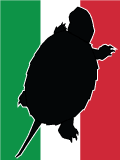Terrapin aches and pains
Parasite borings and other bone modifications in an Italian Pliocene population of Mauremys (Testudines, Geoemydidae)
DOI:
https://doi.org/10.2110/carnets.2025.2513Keywords:
palaeoichnology, Gunnellichnus moghraensis, Karethraichnus lakkos, Thatchtelithichnus holmani, turtle, shell, Piacenzian, Valdelsa basinAbstract
Despite the common and widespread occurrence of turtle shell remains in many fossil vertebrate assemblages worldwide, few palaeontological studies have addressed the palaeoecological significance of turtle bone modification features. Here, we report on ichnofossils occurring on carapacial and plastral bones of the small terrapin genus Mauremys (Testudinoidea, Geoemydidae) from Upper Pliocene deposits exposed at La Serra, in the Valdelsa basin of Tuscany (central Italy). The trace fossil assemblage includes Karethraichnus lakkos, Gunnellichnus cf. moghraensis, and Thatchtelithichnus holmani, all of which are found on the nonvisceral surfaces of the shell. As observed elsewhere, some of the Karethraichnus lakkos borings occur along the epidermal sulci that mark the border between adjacent keratinous scutes. Based on the relevant literature, the studied ichnofossils are interpreted as being due to the parasitic action of leeches/spirorchiid liver flukes (K. lakkos and Thatchtelithichnus holmani) and to algal/fungal/bacterial (sub)cutaneous infections (Gunnellichnus cf. moghraensis). The observed stock of bioerosional features compares favourably with the Italian Pliocene climate, which was warmer and wetter than today.

Downloads
Published
Issue
Section
License
Copyright (c) 2025 Carnets Geol.

This work is licensed under a Creative Commons Attribution-NonCommercial-ShareAlike 4.0 International License.

